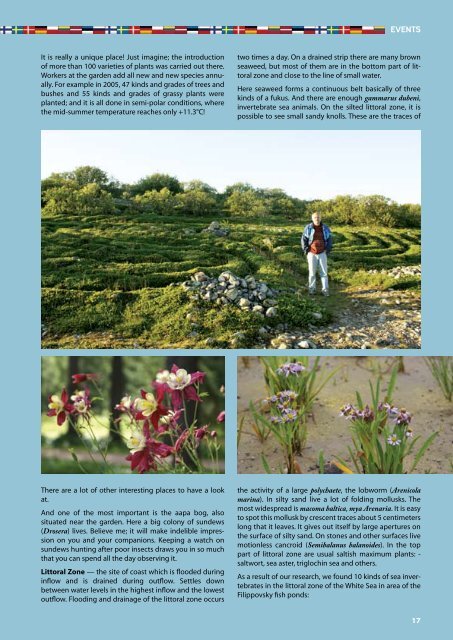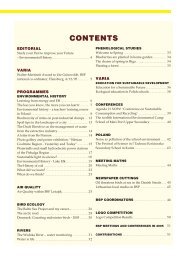newsletter_2008_1.pdf - 5.84 MB - The Baltic Sea Project
newsletter_2008_1.pdf - 5.84 MB - The Baltic Sea Project
newsletter_2008_1.pdf - 5.84 MB - The Baltic Sea Project
You also want an ePaper? Increase the reach of your titles
YUMPU automatically turns print PDFs into web optimized ePapers that Google loves.
It is really a unique place! Just imagine; the introduction<br />
of more than 100 varieties of plants was carried out there.<br />
Workers at the garden add all new and new species annually.<br />
For example in 2005, 47 kinds and grades of trees and<br />
bushes and 55 kinds and grades of grassy plants were<br />
planted; and it is all done in semi-polar conditions, where<br />
the mid-summer temperature reaches only +11.3°C!<br />
<strong>The</strong>re are a lot of other interesting places to have a look<br />
at.<br />
And one of the most important is the aapa bog, also<br />
situated near the garden. Here a big colony of sundews<br />
(Drosera) lives. Believe me; it will make indelible impression<br />
on you and your companions. Keeping a watch on<br />
sundews hunting after poor insects draws you in so much<br />
that you can spend all the day observing it.<br />
Littoral Zone — the site of coast which is flooded during<br />
inflow and is drained during outflow. Settles down<br />
between water levels in the highest inflow and the lowest<br />
outflow. Flooding and drainage of the littoral zone occurs<br />
EvENTS<br />
two times a day. On a drained strip there are many brown<br />
seaweed, but most of them are in the bottom part of littoral<br />
zone and close to the line of small water.<br />
Here seaweed forms a continuous belt basically of three<br />
kinds of a fukus. And there are enough gammarus dubeni,<br />
invertebrate sea animals. On the silted littoral zone, it is<br />
possible to see small sandy knolls. <strong>The</strong>se are the traces of<br />
the activity of a large polychaete, the lobworm (Arenicola<br />
marina). In silty sand live a lot of folding mollusks. <strong>The</strong><br />
most widespread is macoma baltica, mya Arenaria. It is easy<br />
to spot this mollusk by crescent traces about 5 centimeters<br />
long that it leaves. It gives out itself by large apertures on<br />
the surface of silty sand. On stones and other surfaces live<br />
motionless cancroid (Semibalanus balanoides). In the top<br />
part of littoral zone are usual saltish maximum plants: -<br />
saltwort, sea aster, triglochin sea and others.<br />
As a result of our research, we found 10 kinds of sea invertebrates<br />
in the littoral zone of the White <strong>Sea</strong> in area of the<br />
Filippovsky fish ponds:<br />
17





